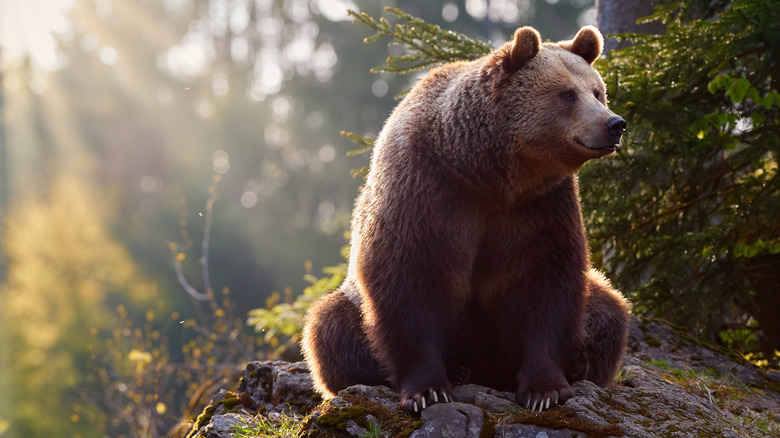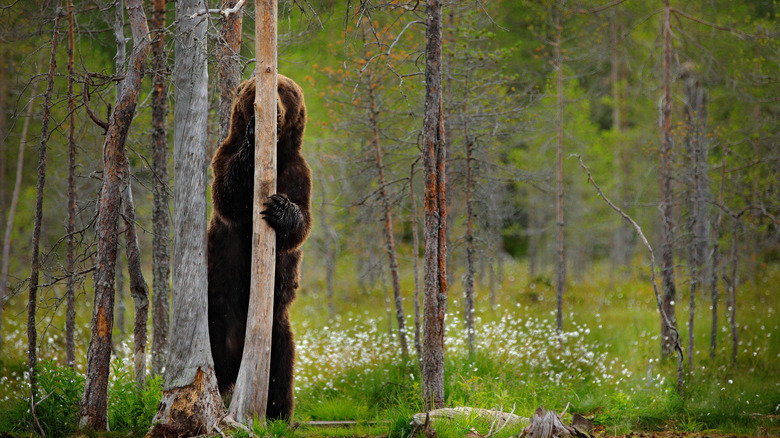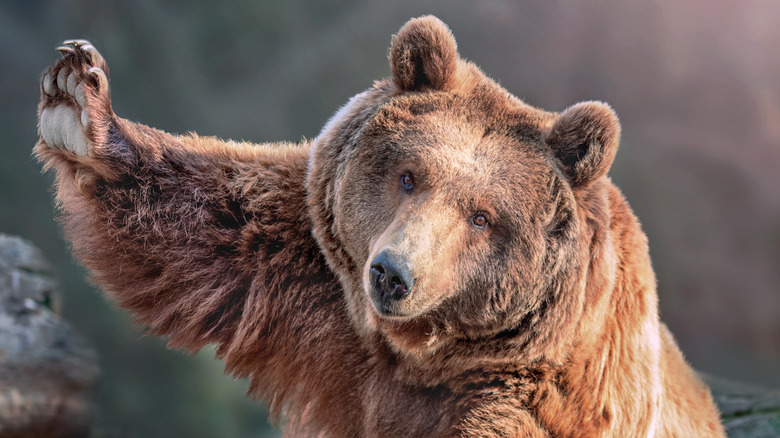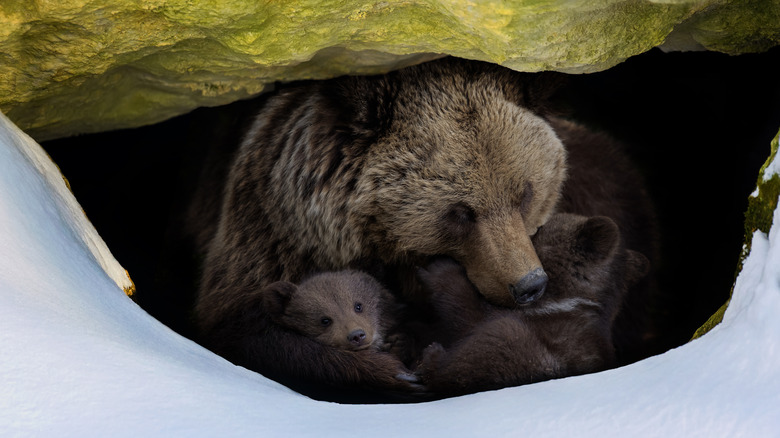The Hilarious Truth About Alaska's 'Fat Bear Week'
What you got hidden under all that chonk, all that chonk, beardonkadonk? Someone better jump on that hook right quick, because we're sure that Fat Bear Week is the rightful champion of any and all tournaments ever — bye-bye, March Madness. And if you haven't heard about Fat Bear Week, or heard the tromp-tromping of its beardaciously bulky bruins bursting believable belly boundaries, then strap in. Belts required.
It's simple, really. Up in Alaska's Katmai National Park and Preserve, loads of bears line up along locations such as Brooks Falls to hunt salmon before descending into their food-deprived winter hibernation. In a turn that may leave many of us paltry, frail-limbed humans jealous, bears intentionally gorge on whatever food they can get. And in Katmai, a vibrant ecosystem flush with salmon, fish fit the bill. As My Modern Met says, brown bears in particular — the kind found in Katmai — pack on up to four pounds a day to survive the winter-long sleep in their den. In six months, they eat a year's worth of food, per the Katmai National Park and Preserve, and then lose about one-third of their body weight while tucked away from the cold.
And in the cleverest vie for conservation that side of the Aleutian Peninsula, the good folks at the Katmai National Park and Preserve, Katmai Conservancy, and Explore.org have devised an annual tournament for people to vote on their favorite tubby teddy before he or she vanishes for another season.
Burly bruins' battle of the bulge
So how does Fat Bear Week work? As the Katmai National Park and Preserve website says, it starts near the end of September and ends on Fat Bear Tuesday at the beginning of October (2021's ran from September 28 – October 5). Park rangers create a single-elimination bracket pitting bear against bear, and every day from 9 a.m. – 6 p.m. PST, people vote for their favorites. There are online chats with naturalists and rangers, classroom activities that teachers can use for students, and a mini Fat Bear Junior competition for "chubby cubbies." Explore.org even has 24-7, looped cam footage of bears poking around in freezing water looking for salmon; It's definitely a sight that would have sent our hunter-gatherer ancestors' heads reeling.
The Katmai National Park and Preserve has detailed bios on each bear, complete with before-and-after slider pictures so you can compare how much weight they've put on. Each bear has a number and a name, physical description, and deconstruction of its personality and habits. 32 Chunk "may wait patiently to scavenge leftover salmon and even play with other bears" despite being a dominant male, 128 Grazer "prefers the lip of Brooks Falls where she's an especially skilled angler," 151 Walker has a "long, tapering muzzle and widely spaced, upright ears," and many more charming examples.
2021's winner? 480 Otis, a now-elderly bear first identified back in 2001 who's missing teeth and park rangers were worried would have trouble getting resources. Instead, Otis reigns supreme.
480 Otis, the elder, reigns supreme
480 Otis was, in fact, 2014's inaugural winner of what would eventually become Fat Bear Week. Back then, it was just one day, Fat Bear Tuesday. Bit by bit, the event's popularity has grown: 55,000 total voters in 2018, 250,000 in 2019, and 650,000 in 2020, as Mental Floss describes. Mike Fitz, resident naturalist for Explore.org and the founder of Fat Bear Week, said, "Working on the webcam — and even prior to that, just being a ranger at Katmai and talking to people when they were watching the bears — I knew that bears were very charismatic creatures. I knew that people are very curious about [the bears'] lives and how they make a living, and the point of Fat Bear Week is to make some of those stories more accessible to people and do it in a fun way."
With humor, warmth, wit, and phrases such as "747 cultivates mass at an exceptional rate," Fitz, on his blog FitzNaturalist, goes into details about bear anatomy and habits. Even before putting on winter weight, their bodies are 20-30% fat. When they hibernate, they don't even urinate because their body produces so little water, it's just reabsorbed by their kidneys. The biggest bears? They can eat a staggering 6,000 to 10,000 pounds of salmon a year.
As Explore.org shows us, 2021's final round pitted 480 Otis against 151 Walker. Otis won by 51,230 votes to 44,384.
Conservation is the point
It's important to bear in mind: none of Fat Bear Week is done in poor spirit whatsoever. Massive, fatty bears mean a healthy ecosystem, and so the whole tournament is a celebration of nature, in general, and the strength of the ecosystem in Katmai, specifically. Put differently: conservation is the point to this hullabearloo. The Katmai National Park and Preserve's gloriously wordplayed Twitter feed demonstrates the spirit of things: "The people have spoken! The portly patriarch of paunch persevered to pulverize the Baron of Beardonkadonk in the final match of #FatBearWeek 2021." Is there a better way to ensure that people care about nature? We think not. That's just science.
Previous Fat Bear Week winners include, per Katmai National Park and Preserve, 409 Beadnose (2015 and 2018), 435 Holly (2019), the airplane-monikered "747" (2020), and 480 Otis himself (2014, 2016, 2017, and now 2021). Otis' biggest strength is his patience, as the bear biographies on the Katmai National Park and Preserve website state. Rather than try to muscle his way into busy areas or compete with younger bears, he just sort of sits in one spot and stares at the water as though he's dozing. As a result of such unobvious mastery, he's got a super high salmon catch rate.
The Katmai Conservancy has even created an Otis Fund to help fund park and visitor services, community outreach, brown bear genetics projects, and more. In 2021 they "far exceeded" their goal of $250,000.



